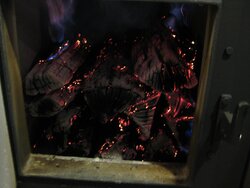So my wife and I bought a new (to us) house and it came with an old Johnson Energy Systems wood eating smoke breathing dragon of a furnace. What a deal rite? Well sort of. Since I grew up burning wood and was, at the old house in my Some what reformed smoke dragon of a Sierra I had a nice stock pile of cut, stacked and dry hard maple and oak. So far so good but her is the rub. This thing is a %$#@! It's eating my beautiful pile of wood like a kid eats candy! In one way I can't complain, we are in the country and we are on LP but have used hardly any thanks to this beast so it's saving us big $$$. It has taken a little getting used to but thanks the things I have learned here I have gotten on to firing this monster, I mean this thing has a fire box like a steam locomotive! I swept the stack (it was bad) and over the last month or so it still looks pretty good considering but something has to give!
So here's the plan, please let me know what you think. I really would like to install a Kumma but the budget will not allow that rite now so I'm thinking that a Dorlet Tundra will be purchased and installed this summer along with a chimney liner. We will burn it for a few years until the bank account will allow the purchase of a Kumma. At that point my brother will inherit the tundra and we will sell his Fire Chief to recover some of the cost of the Kumma and the world will once more be at peace! So what a ya think? feed back, pointers, criticism, considerations. It's all welcome. Let me have it!
So here's the plan, please let me know what you think. I really would like to install a Kumma but the budget will not allow that rite now so I'm thinking that a Dorlet Tundra will be purchased and installed this summer along with a chimney liner. We will burn it for a few years until the bank account will allow the purchase of a Kumma. At that point my brother will inherit the tundra and we will sell his Fire Chief to recover some of the cost of the Kumma and the world will once more be at peace! So what a ya think? feed back, pointers, criticism, considerations. It's all welcome. Let me have it!




